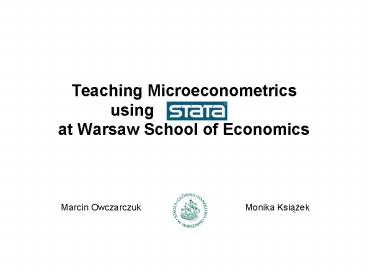Teaching Microeconometrics using at Warsaw School of Economics - PowerPoint PPT Presentation
Title:
Teaching Microeconometrics using at Warsaw School of Economics
Description:
... present income 2 Coping on present income 3 Finding it difficult on present income 4 Finding it very difficult on present income Independent variables: Continous ... – PowerPoint PPT presentation
Number of Views:75
Avg rating:3.0/5.0
Title: Teaching Microeconometrics using at Warsaw School of Economics
1
Teaching Microeconometricsusing at Warsaw
School of Economics
- Marcin Owczarczuk Monika Ksiazek
2
Agenda
- What is microeconometrics
- Microeconometrics the lecture
- How do we teach
- Ordinal outcome models
- Count outcome models
- Limited outcome models
3
Microeconometrics
- Microdata
- Individuals
- Households
- Companies
- Microeconometrics econometrics for
microdata - Fields of application
- Marketing
- Finance
- Social science
4
Microeconometrics the lecture
- 15 lectures (2h each)
- Theory applications
- Applications on publicly avaiable datasets
- Calculations in STATA
- Maximum likelihood
- Binary, multinomial, ordinal, count, limited
dependent variables - Cross-sectional data only
5
Ordinal outcome models
6
Data
- European Social Survey, vawe 3, Poland
- Ordinal dependent variable (ocdoch)Which of the
descriptions on this card comes closest to how
you feel about your households income
nowadays?1 Living comfortably on present
income2 Coping on present income 3 Finding it
difficult on present income 4 Finding it very
difficult on present income - Independent variables
- Continous AGE (wiek)
- Binary CHILDREN (dzieci)
- Nominal (3 categories) PROFESSION (zawód
kierownicy, pracownicy)
7
OLOGIT, OPROBIT, GOLOGIT
- Significance testing
- Single variable
- Variable set
- Whole model
8
Parallel regressions assumption testing
- Wolfe Gould
- LR ologit vs gologit
- Brant
Assumption holds ? standard model is OK
9
Model quality assessment
- Model fit
- Predictive capacities
predict prob1, outcome(1)
10
Parameters interpretation
- Compensating effect
- Marginal effect
- Odds ratio
11
Count outcome models
12
Data
- CBOS survey Living conditions of Polish people
problems and strategy - Dependent variable number of small children (up
to 6 year old) in a young family (20-35 year old)
13
Poisson regression
14
Negative binomial regression(allows for
overdispersion)....
No overdispersion ?Poisson model is OK
15
Zero inflated (Poisson) model
(Poisson model)
(Binary logit model P(Y0))
ZIP fits better than standard Poisson model
16
Limited outcome models
17
Data
- PVA (US not-for-profit organisation) which rises
funds by direct mailings - Donors differ in amounts and frequencies of gifts
- Explanatory variables
- history of previous mailings
- characteristics of the donors neighbourhood
18
Tobit regression
Target_d amount given in last mailing (many
zeros)
19
Truncated regression
Target_d amount given in last mailing (no
zero observations)
20
Sample selection, maximum likelihood
Positive correlation who gives more, gives less
frequently
Significant correlation
Srednia_odleglosc average distance (in days)
between gifts sredni_datek average
amount selekcja 1 if more than 6 gifts were given
21
Sample selection, two step
Inverse Mills ratio
22
Coming soon September 2010































